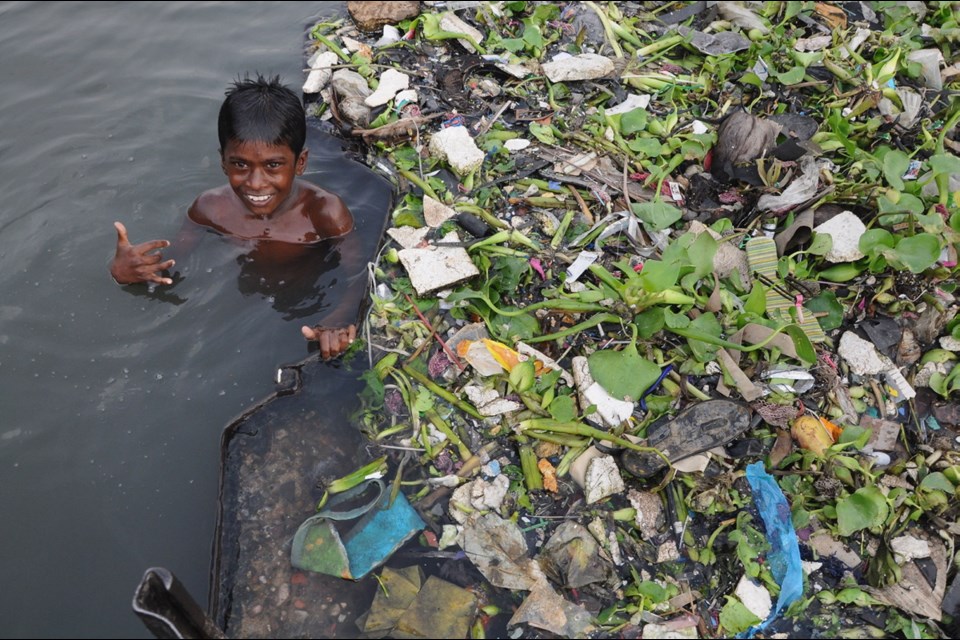The water bottle could be from Los Angeles, the food container from Manila and the plastic bag from Shanghai.
But whatever its source, almost all of the trash in the infamous Great Pacific Garbage Patch comes from countries around the Pacific Rim, including Canada.
Concerned about the millions of tons of garbage in the patch — a floating blob of trash halfway between California and Hawaii that’s twice the size of Texas — the Ocean Cleanup project is sending out a giant floating trash collector to try to scoop it up. The first of its cleanup systems launched Saturday near San Francisco.
It’s a daunting task: The patch includes about 1.8 trillion pieces of trash and weighs 88,000 tonnes — the equivalent of 500 jumbo jets.
And while many scientists say it’s great that people are trying to clean up the patch, others say most of our efforts should instead go towards stopping the out-of-control flow of plastic garbage into the ocean.
How much more? Try putting 95 per cent of our efforts on stopping plastic from entering the ocean, and only five per cent on cleanup, says Richard Thompson, head of the International Marine Litter Research Unit at the University of Plymouth in the United Kingdom.
Thompson said a massive, global-scale effort is needed to combat the problem, one that includes contributions from individuals, policymakers and industry. “The way we use plastics — from design, to use, to disposal — must be done more efficiently and in a more environmentally friendly manner.”
George Leonard, chief scientist with the Ocean Conservatory, said that “the clock is ticking; we must confront this challenge before plastics overwhelm the ocean.”
Where does it come from?
Discovered in the early 1990s, the garbage patch’s trash comes from countries around the Pacific Rim, including nations in Asia and North and South America, according to Laurent Lebreton of the Ocean Cleanup Foundation.
But specifically, scientists say, the bulk of the garbage patch trash comes from China and other Asian countries.
This shouldn’t be a surprise: Overall, worldwide, most of the plastic trash in the ocean comes from Asia. In fact, the top six countries for ocean garbage are China, Indonesia, the Philippines, Vietnam, Sri Lanka, and Thailand, according to a 2015 study that appeared in the journal Science.
The United States contributes as much as 109 million kilograms of plastic trash to the ocean per year, according to that study.
China has begun to take steps to stem the tide of trash that’s floating away from its shores. The country recently banned the import of most plastic waste, according to a study published in June in Science Advances.
China has imported about 45 per cent of the world’s plastic waste since 1992 for recycling, the study found. In the U.S. alone, nearly 4,000 shipping containers full of plastic recyclables a day had been shipped to Chinese recycling plants.
Now where will all that waste go?
“It’s hard to predict what will happen to the plastic waste that was once destined for Chinese processing facilities,” said Jenna Jambeck, associate professor at the University of Georgia’s College of Engineering and co-author of the study. “Some of it could be diverted to other countries, but most of them lack the infrastructure to manage their own waste let alone the waste produced by the rest of the world.”
That decision means the U.S. and other industrialized countries that have been exporting their plastic waste to China for recycling will need to find new ways to handle the disposal of their trash, as much of it is already starting to pile up in landfills.
The trash in the ocean could be around for a very long time: “Most plastics don’t biodegrade in any meaningful sense, so the plastic waste humans have generated could be with us for hundreds or even thousands of years,” Jambeck said.
Since plastic has been around only since the 1950s, there’s no way of knowing exactly how long it will last in the ocean. If left alone, the plastic could remain there for decades, centuries or even longer, Jambeck said.
And we’re talking a lot of trash.
Every year, an estimated eight to 12 million metric tons of plastics enter our ocean on top of the estimated 150 million metric tons that are already in our marine environments, according to the Ocean Conservancy.
Whether by errant plastic bags or plastic straws winding their way into gutters or large amounts of mismanaged plastic waste streaming from rapidly growing economies, that’s like dumping one New York City garbage truck full of plastic into the ocean every minute of every day for an entire year.
From the tiniest plankton to the largest whales, plastics affect nearly 700 species in our ocean. And, incredibly, our trash has reached the stomachs of some of the deepest fish in the ocean.
Researchers said 73 per cent of deepwater fish in the North Atlantic Ocean had eaten particles of plastic, known as microplastics. This is among the highest percentages ever found in fish on Earth, according to a recent study.
Another study by the British research firm Eunomia said there may be as much as 70 million tonnes of plastic waste on the sea floor alone.
And it’s not just fish or marine life, it’s us, too: Rolf Halden, a professor of environmental health engineering at Arizona State University, said that every human being in the developed world has traces of plastic in their blood.



